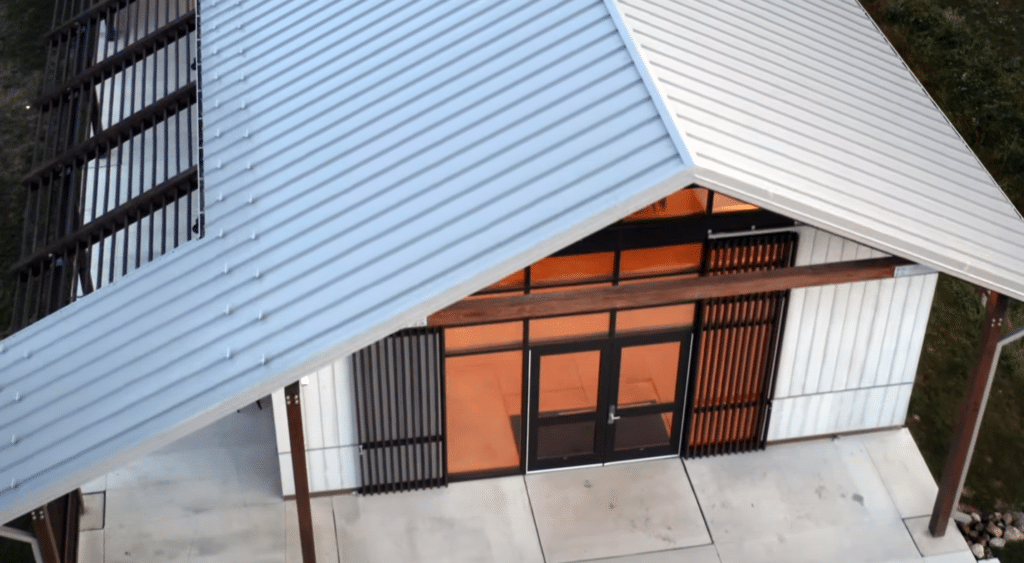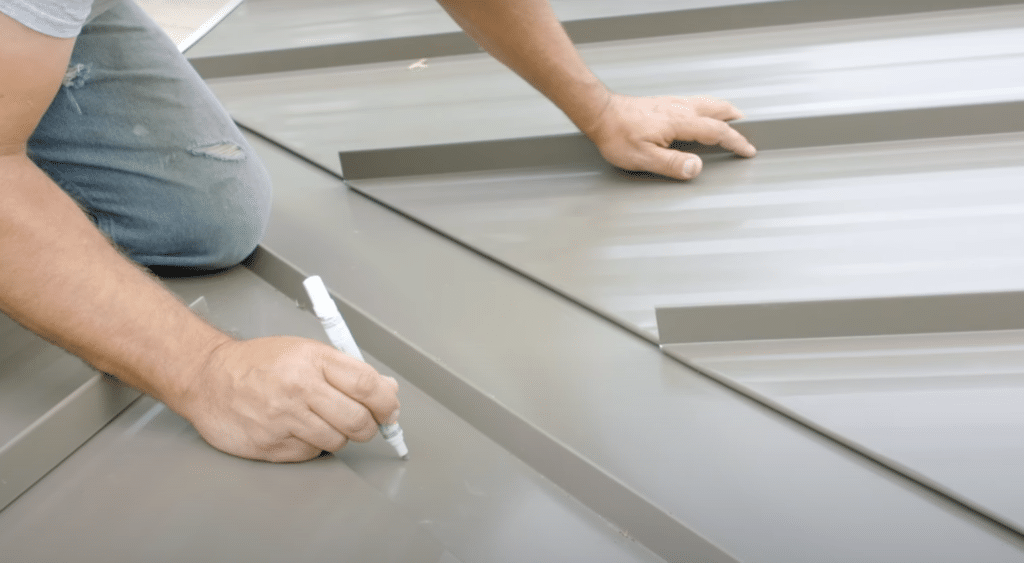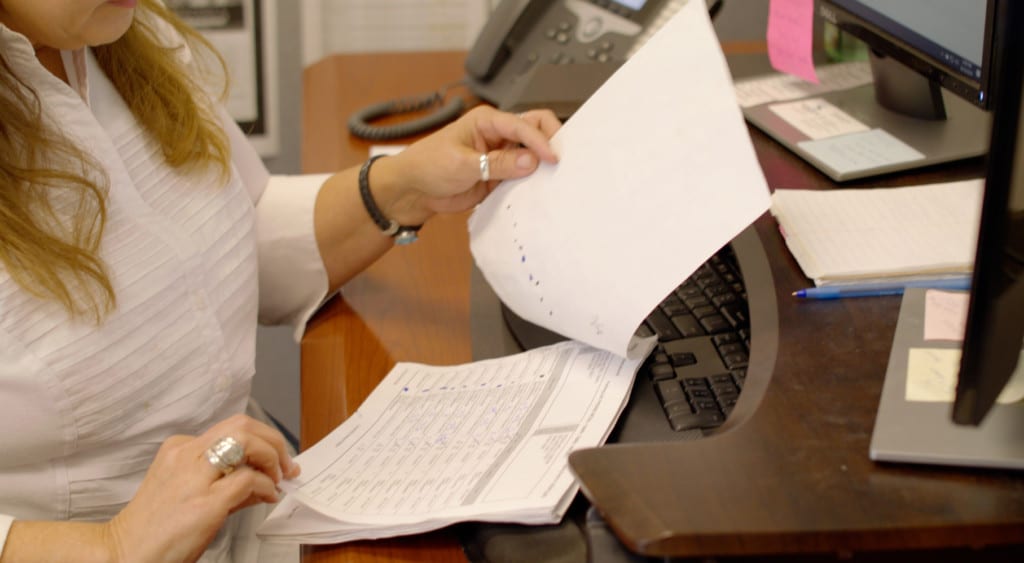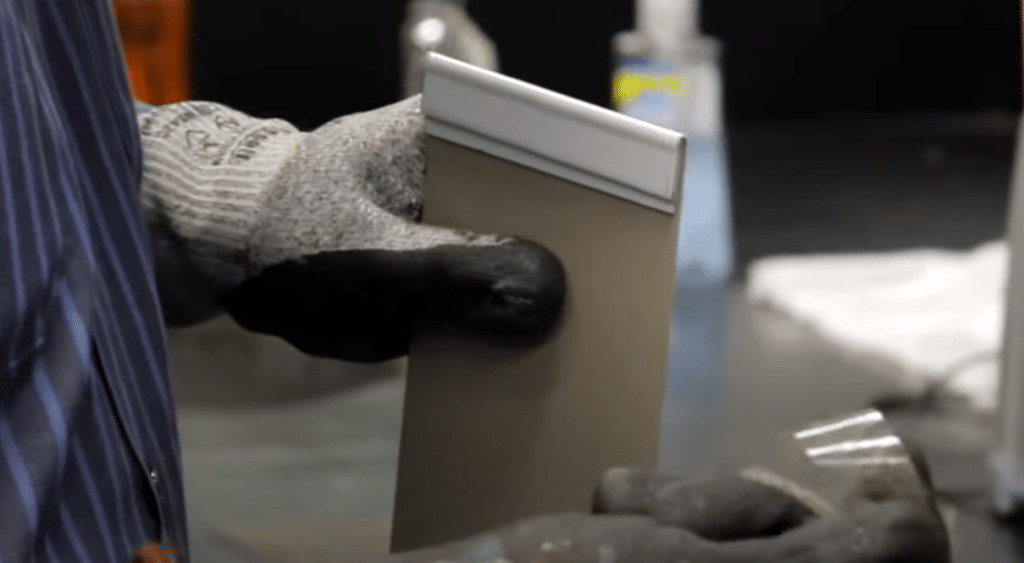When you buy something as significant as a new metal roof, one of the best parts are the warranties offered with the roof by the manufacturer. These warranties will vary depending on where the metal came from, but you can likely expect at least a paint warranty and even a substrate warranty.
While the majority of property owners won’t ever need to submit a warranty claim, how much do you know about the warranty claims process? Do you know the steps of the claims process that would occur if you were to notice a potential problem on your metal roof?
For over 25 years, our team at Sheffield Metals has worked with our paint and metal partners to create a comprehensive and thorough warranty claims process. This allows us to ensure all claims are investigated and determinations as to whether the issue is warrantable or not are clear.
In this article, we’ll walk you through:
- A recap of the common paint and substrate warranty types
- Who to contact to begin a warranty claim
- The common steps of the claims process at Sheffield Metals
Types of Warranties Commonly Offered for Metal Roofing
Before we get into the steps of filing a claim with us, let’s discuss the two warranty types included in this process: paint and substrate warranties.
Substrate Warranties for Metal Roofing Systems
A substrate warranty guarantees that the base metal will not, as a result of corrosion, rupture, structurally fail, or perforate within specified terms when exposed to normal atmospheric conditions.
Galvalume® Substrate Warranties
One of the most common substrate warranties comes on Galvalume® sheet and coil products. While the duration/terms will vary from manufacturer to manufacturer, a typical Galvalume substrate warranty ranges from 15 to 25.5 years.
When you’re looking at the substrate warranties on Galvalume products, there might be more than one because of the different ways a coil can be coated or uncoated. For example, there’s often a painted Galvalume substrate warranty, which may also be called “AZ50.” Then, there’s also an unpainted (or acrylic-coated) Galvalume substrate warranty, which may also be referred to as “AZ55.”
Common Situations NOT Covered by a Galvalume® Substrate Warranty
- Areas subjected to constant spraying of either salt or freshwater. Most importantly, coastline areas with marine exposure within the following distances:
- Coastline with breaking surf within 1500 feet
- Coastline with large bay within 800 feet
- Coastline with marsh within 400 feet
- Areas subject to fall-out exposure to corrosive chemicals, ash, fumes, cement dust, animal waste (or its decomposition by-products), the fall-out from copper, lead, nickel/silver mining, refining operations, and carbon black.
- Buildings where animals are confined (manure from the animals breaks down into ammonia gas over time and then reacts with the Galvalume coating).
- Conditions where corrosive fumes or condensation are generated or released indoors.
- Areas subject to water run-off from lead or copper flashing or piping/areas in contact with lead, copper, or lumber.
- Mechanical, chemical, or other damage sustained during shipment, storage, forming, fabrication, etc.
- Failure to provide free drainage of water and failure to remove debris from overlaps and all other surfaces of the sheets or panels.
- Improper rollforming, bending, scouring, or cleaning procedures.
- Roof slope or sections of the roof flatter than 1:15.
While this list is not all-encompassing, it does outline some common situations that a Galvalume substrate warranty doesn’t cover. Therefore, it’s critical to read every inclusion and exclusion outlined in the warranty provided by the manufacturer.

Aluminum Substrate Warranties
You’ll also see manufacturers offer substrate warranties on painted aluminum products, which are better suited for saltwater environments than Galvalume products. They also often have a shorter term than Galvalume warranties and can come with a duration of about 20.5 years or less.
Common Situations NOT Covered by an Aluminum Substrate Warranty
- Areas subject to fall-out exposure to corrosive chemicals, ash, fumes, cement dust, animal waste (or its decomposition by-products), the fall-out from copper, lead, nickel/silver mining, refining operations, and carbon black.
- Conditions/circumstances where corrosive fumes or condensation are generated or released inside the building.
- Areas subject to water run-off from lead or copper flashing or piping/areas in contact with lead, copper, or lumber.
- Mechanical, chemical, and other damage sustained during shipment, storage, forming, fabrication, during, or after erection.
- Slope of the roof or sections of the roof flatter than ¼:12.
- Deterioration of the panels caused directly or indirectly by contact with fasteners.
- Failure to perform an annual fresh tap water rinse on pre-painted aluminum located within one mile of a seacoast, saltwater, brackish water, etc.
- Being installed past the waters edge or coming directly in contact with saltwater.
Again, while this list is not all-encompassing, it does outline some common situations that aren’t covered by an aluminum substrate warranty. Always be sure to read every inclusion and exclusion in the warranty provided by the manufacturer.
Paint Warranties for Metal Roofing Systems
A paint warranty is a guarantee from a manufacturer/paint supplier that the paint system applied to the metal substrate will not degrade to a certain degree within a specific time frame.
What Does a Paint Warranty Cover?
Commonly, paint warranties cover the following phenomenons:
- Cracking, flaking, or peeling – To the extent that is visible on ordinary outdoor visual observance (this portion specifically refers to paint adhesion).
- Chalking – Defined as a resin system degradation and loss of adhesion on the paint’s surface that results in a white coating. Most warranties ensure the metal roof or wall system will exceed a specified chalking number. Keep in mind that roof and wall panels usually have different degrees of chalking because the roof will have significantly more UV exposure than walls.
- Color fading – Occurs when the paint’s pigment breaks down and alters the color, exceeding a specified ASTM D-2244 Hunter Delta E (DE) unit. The amount of fade is determined on a number scale by comparing a sample to the baseline color, and every paint warranty should specify the allotted amount of change in Hunter units over a certain length of time.

What Does a Paint Warranty NOT Cover?
This section outlines the circumstances that would not warrant a replacement of the metal roofing (this list is not all-encompassing; please read the warranty for specific exclusions/inclusions):
- Fire, deliberate damage, wind damage, or improper handling by installers.
- Foreign substances or chemicals present in the environment and inside of the structure.
- After-the-fact additions to a roof that may affect the chemical make-up, such as adhered solar panels, snow guards, etc.
- Liquid or solid material submersion.
- Altered or sculpted beyond what it was intended for.
- Stored or installed in a way that allows for poor air circulation.
- Exposure to animals or animal waste.
- Complimentary roof products, fasteners, or penetrations that could cause a galvanic reaction and ruin the finish or corrode the metal.
- Using non-standard industry installation details.
- Using details that do not allow for moisture to run off or evaporate.
Common Triggers of a Warranty Claim for a Metal Roof
Several situations might trigger a property owner to start the claims process. For the most part, it tends to begin because of some level of visual irregularity, including:
- Red rust
- Discoloration of the paint/metal coating
- Blotchy spots in a small or large portion of the roof
- Chipping or flaking paint on the seam of the roof panel(s)
- Excessive or premature chalking or fading
Most manufacturers, including Sheffield Metals, require you to address any issue you notice on your metal roofing system within a specific number of days (i.e., 60 to 90 days). Sometimes, property owners see a problem and then wait a season or two for the weather to become more favorable; do NOT do this. If you notice rust, discoloration, or other abnormality on your property, it’s critical to start the claims process as soon as possible.

The issue you see may turn out to be normal or remediated with something as simple as a PVDF paint pen. Or, it could be something that will get worse with time and may cause your entire roof system to fail eventually. That’s why we highly recommend you bring it to the attention of the manufacturer immediately upon discovery.
Who to Contact for a Warranty Claim
We strongly encourage property owners to get in touch with the manufacturer of the roofing system or the material, as they are typically the best starting point for any warranty claim.
We often receive phone calls from people who don’t know who the roof manufacturer is on a home or property they recently purchased. You still should be able to reference the warranty documents or information provided by the previous property owner to find the manufacturer. Or, you can always go to your county’s building department to pull the permit for the roof on your home or property. The manufacturer’s information is typically provided on the permit.
Keep in mind that manufacturers can’t get involved in claims where their metal is not used.
Timing for a Paint or Substrate Warranty Claim at Sheffield Metals
One of the most common questions we get from property owners during this process is: How long can I expect my claim to take?
Well, it depends.
The process can vary dramatically from claim to claim. But the fastest way to get the ball rolling is to have all of the warranty documents and product source information ready to go before you contact us.
Plus, if your claim merits a field inspection, the process will take a little longer. Most inspection companies require two or three weeks’ notice to book flights. Or, they may already have several claims already lined up. Once the inspection occurs, it will take another couple of weeks to make a factual determination.
All-in-all, especially during the current COVID-19 pandemic, you can expect the warranty claims process to take about two to three months.
Paint and Substrate Warranties Claims Process at Sheffield Metals

#1: Track down and identify the original warranty documents.
Once you’re sure the manufacturer is Sheffield Metals and you’ve contacted us, the first thing we’re going to do is pull our records to verify the warranty’s existence. In the past, we’ve run across property owners who wanted to file a paint or substrate warranty claim, but never their contractors request or apply for their warranty in the first place. Unfortunately, there’s not much we can do, which is why it’s always critical to request the warranty at the time of installation from your contractor.
If you’ve kept the copies of your warranty documents and can present them at this point, it will allow us to identify your warranty coverage much quicker. That’s why we always recommend that you keep a copy of your warranty in a safe place with other important documents.
If you don’t have your warranty documentation, we will have to go through our database to track down the information. This may take a little bit of time, depending on the age of your roof.
#2: Look at project information and product records.
Once we have located the warranty, we’re going to look at the specific project information and the product records.
For reference, we’re looking for:
- Who/what company we initially sold the metal sheet and coil to.
- Who/what company rollformed and/or installed the metal.
- Where the source mill was for that particular steel item (substrate warranties).
- Where the source paint line was for the paint and coating application (paint/finish warranties).
Upon identifying this information, we then initiate the claim on our end with our suppliers or partners. For a substrate warranty, it would include the steel mill where the metal originated. If it’s a paint warranty, it includes the paint supplier, typically Sherwin-Williams, and the corresponding coating company for a paint warranty.
Our representatives at Sheffield Metals will work with our suppliers to determine the next steps.
#3: Collect and analyze information, photos, and other evidence from the property owner.
When we know the sourcing information from our supplier, we’ll ask for additional photos of the problem on the roof and a description of what initiated the claim.
The more in-depth, detailed, and high-quality the photos and information are from the property owner, the better. In some cases, we may even be able to make a determination based on the images or information provided, which we would typically do at this point, if possible.
If it’s not abundantly clear what the issue is, we’ll move into the next step of the process.
#4: Review the hold-back product sample kept by the suppliers.
Our suppliers, especially when it comes to paint-lines, excel at keeping detailed “hold-back” samples for every single coil that runs through the line. They hold on to these samples for the duration of any warranty, which allows them to go back and revisit if a claim comes up.
If we contact the paint line or steel mill, they will go into their hold-back samples to find the piece from the same coil that your roof came from, which allows them to go back and test the sample for any defects.
For a paint warranty, it’s helpful to keep in mind that coil coating is a highly technical coating process, which means they will take their time to verify that the sample meets the adequate testing standards.

For example, the paint line company will likely run these tests (and more in some cases) to verify:
- Dry film thickness, or DFT (the thickness of a coating as measured above the substrate)
- Impact resistance
- Humidity resistance
- Pencil hardness
- Film adhesion
- Salt-spray (if applicable)
- T-bends
#5: If an issue is detected, paint manufacturer, paint line, or steel mill representatives will be sent to the location to investigate.
If the hold-back sample shows signs of a defect or we’re still unable to determine the root cause of the issue, the next step is to send out an inspector and a representative from one of our suppliers (steel mill representative for substrate claims or a paint line/supplier representative for paint claims) to the home or property where the issue is happening.
When someone looks at and investigates the potential issue first-hand in person, it ensures that we’re making the correct determination. Plus, it gives us another set of eyes on the problem to verify what we believe to be the root cause.
#6: Work together to come to a resolution, whether it falls under a warranty or not.
Once we go through the entire process of getting photos, gathering source information, involving our partners, checking the hold-back sample, and going out to the location, we can typically make a determination as to whether the problem is covered under the warranty or not.
When the Claim Is NOT Covered
Suppose the problem is NOT a warrantable condition. In that case, we’ll inform the property owner of our findings and provide information about what likely caused the issue to occur.
For example, here are a select few common root causes that might cause damage to the roof that is NOT covered by a warranty:
- A third-party came to install a satellite dish, put up solar panels, paint the property, etc., and ended up penetrating or scratching up the roof. The best way to combat this issue is to ask questions of the third-party before they begin any work on the roof, such as:
- What are you doing to make sure you don’t void my roof warranty?
- Are you planning to drill any holes into the face of metal?
- Are you using non-penetrating attachment solutions to mount this object?
- The installer or someone else tried to use a spray paint that wasn’t PVDF to cover up scuffs or scratches, which caused blotching and discoloration.
- The correct installation details weren’t used by the contractors who initially installed the roof.
These are just a few examples that tend to be root causes. Always make sure to reference your warranty documentation for the full list of inclusions and exclusions.
When the Claim IS Covered
If we conclude that there is a manufacturer defect or the issue falls under the warranty inclusions, then the home or property owner will be getting a new replacement metal roof for the areas that failed, which is 100% covered by us.
One of the great things about the relationships we have with our suppliers and partners is that we work well together to ensure that any warrantable claim is honored.
Once we’ve had a conversation with the property owner, we’ll then involve a local metal roofing installer (it’s often the contracting business that did the initial installation) to schedule the new replacement metal roof installation.
Final Thoughts on the Paint & Substrate Warranty Claims Process
While it might seem daunting to submit a warranty claim and start down the process, it ensures that you’re getting the most out of your investment on a warrantable roofing product.
To recap:
- Always make sure you verify what company manufactured your roof/roofing materials before you contact them.
- The best way to make the process go a little faster is to have your warranty documents and records ready to go before you begin the claims process. Additionally, make sure you requested a warranty through your contractor at the time of the installation.
- A detailed description and clear photos will be helpful during the investigation portion of the process. Some determinations can even be made with this information.
- If anyone is doing work on your completed and warranted roof, make sure you ask if they need to penetrate the surface of the roof and/or what they are doing to minimize any interaction with the roof that could cause damage.
As mentioned, most metal roof owners won’t have a warranty-related problem, but it’s best to know what to do if you should. Our team at Sheffield Metals is ready to discuss your warranty and if you think a claim should be initiated.
For warranty questions or to connect directly with one of our warranty claims representatives, contact us today.
